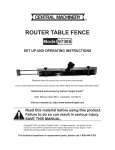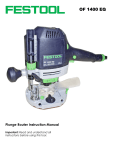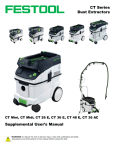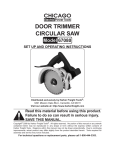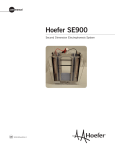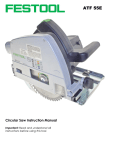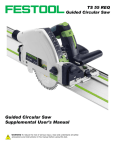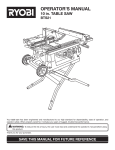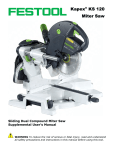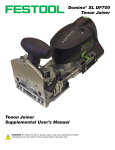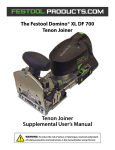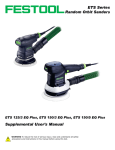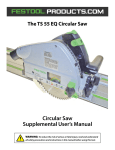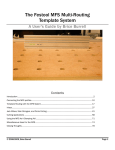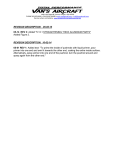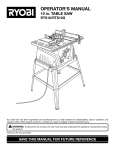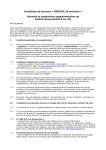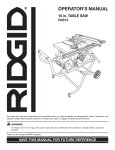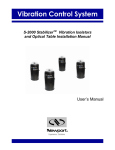Download Router Table Supplemental User`s Manual
Transcript
CMS of GE and VL Router Tables Router Table Supplemental User’s Manual WARNING: To reduce the risk of serious or fatal injury, read and understand all safety precautions and instructions in this manual before using this tool. Limited Warranty 30 Day Money Back Guarantee We are so confident that you will thoroughly enjoy our tools, that we offer a 30 day money back guarantee. If you are not completely satisfied, your full purchase price will be refunded, excluding all freight charges. 1+2 Limited Warranty Festool USA offers a 3-year limited warranty, one of the longest in the industry. This warranty is valid on the pre-condition that the tool is used and operated in compliance with the Festool operating instructions. Festool USA warrants that the specified tool will be free from defects in materials and workmanship for a term of 3 years from the date of purchase. Conditions of 1+2 Limited Warranty You are entitled to a free extended limited warranty (1 year + 2 years = 3 Years) for your Festool power tool. Festool USA is responsible for all shipping costs during the first year of the warranty. During the second and third year of the warranty, the customer is responsible for shipping the tool to Festool. Festool will pay for return shipping to the customer using UPS Ground Service. All warranty service is valid 3 years from the date of purchase on your receipt or invoice. Excluded from the coverage under this warranty are: normal wear and tear, damages caused by misuse, abuse, or neglect; damage caused by anything other than defects in material and workmanship. This warranty does not apply to accessory items such as circular saw blades, drill bits, router bits, jigsaw blades, sanding belts, and grinding wheels. Also excluded are “wearing parts,” such as carbon brushes, lamellas of air tools, rubber collars and seals, sanding discs and pads, batteries, and Festool gear (hats and t shirts). The obligations of Festool USA in its sole discretion under this warranty shall be limited to repair or replacement or a refund of the purchase price for any Festool portable power tool that is found to have a defect in materials or workmanship during the warranty period. FESTOOL USA SHALL NOT BE LIABLE FOR ANY CONSEQUENTIAL, INCIDENTAL OR SPECIAL DAMAGES REGARDLESS OF THE THEORY OF LAW ON WHICH THE CLAIM IS BASED. ALL WARRANTIES IMPLIED BY STATE LAW, INCLUDING THE IMPLIED WARRANTIES OR MERCHANTABILITY AND FITNESS FOR A PARTICULAR PURPOSE ARE HEREBY LIMITED TO THE DURATION OF THREE YEARS. Some states in the U.S. and some Canadian provinces do not allow the limitations on how long an implied warranty lasts, so the above limitation may not apply to you. This warranty gives you specific legal rights, and you may also have other rights that vary from state to state in the U.S. and from province to province in Canada. With the exception of any warranties implied by state or province law as limited above, the foregoing express limited warranty is exclusive and in lieu of all other warranties, guarantees, agreements, and similar obligations of Festool USA. Festool USA makes no other warranty, express or implied, for Festool portable power tools. No agent, representative, distributor, dealer, or employee of Festool USA has the authority to increase or otherwise change the obligations or limitations of this warranty. Repairs If your Festool power tools require repair, you must contact our Service Department at (800) 554-8741 for authorization and address details. No collect shipments will be accepted. No Festool hats, t-shirts or other wearables may be returned. Also contact our Service Department at the telephone number listed above if you have any questions about warranty claim procedures. Returns If you need to return your Festool tools for any reason, please return it to the dealer from which you originally bought the tool. Liability Statement This product has been built to the high standards of Festool. Please do not attempt to operate or repair this equipment without adequate training. Any use, operation, or repair in contravention of this document is at your own risk. By acceptance of this system you hereby assume all liability consequent to your use or misuse of this equipment. Festool USA assumes no liability for incidental, special, or consequential damage of any kind. Equipment specifications, applications, and options are subject to change at the sole discretion of Festool USA without notice. Proprietary Notice All drawings and information herein are the property of Festool, TTS Tooltechnic Systems AG & Co. KG. All unauthorized use and reproduction is prohibited. Written and Illustrated by Rick Christopherson. © 2012 TTS Tooltechnic Systems AG & Co. KG All rights reserved. Printed in the United States of America and Germany. 2 Festool USA is a division of Tooltechnic Systems, LLC. Festool is a trademark and service mark of TTS Tooltechnic Systems AG & Co. KG Domino, Plug-It, and Systainer are registered trademarks of TTS Tooltechnic Systems AG & Co. KG www.festoolusa.com CMS OF Router Table Contents About This Manual ........................................... 3 Tool Symbols ................................................... 3 General Power Tool Safety Warnings .............. 4 Work Area Safety .......................................... 4 Electrical Safety ............................................ 4 Personal Safety ............................................. 4 Power Tool Use and Care ................................ 4 Service ........................................................ 5 Specific Safety Rules for Table Mounted Routers ... 5 Respiratory Exposure Safety Warnings ................ 5 Tool Description .............................................. 5 Technical Specifications ..................................... 5 Intended Use................................................... 5 Functional Description ...................................... 6 Setup............................................................... 7 Setting up the GE Base. .................................... 7 Setting up the VL Base. .................................... 7 Installing an OF 1010 Router ............................. 8 Installing an OF 1400 Router ........................... 11 Setting up the Fence ...................................... 15 Assembling the Optional Vacuum Splitter Hose ... 16 Setting up the Optional Extension Table ............ 17 Setting up the Optional Sliding Table ................ 18 Operation ...................................................... 20 Changing Router Bits ...................................... 20 Freehand Routing with a Piloted Bit .................. 21 Fence Guided Profile Routing ........................... 22 Cope and Stick (Stile and Rail) Routing ............. 23 Offset Fence and Jointer Routing ...................... 25 About This Manual Save These Instructions It is important for you to read and understand this manual. The information it contains relates to protecting YOUR SAFETY and PREVENTING PROBLEMS. The symbols below are used to help you recognize this information. WARNING! Indicates a potentially hazardous situation which, if not avoided, could result in death or serious injury. CAUTION! Indicates a potentially hazardous situation which, if not avoided, could result in minor or moderate injury. NOTICE: Indicates a potential situation which, if not avoided, can result in property damage or damage to the tool. Note: Indicates information, notes, or tips for improving your success using the tool. Tool Symbols V W Hz ~ no Ø Volts Watts Hertz Alternating Current (AC) No-load Speed Diameter Class II Double Insulated Supplemental Owner’s Manual 3 General Power Tool Safety Warnings WARNING! Read all safety warnings and instructions. Failure to follow the warnings and instructions may result in electric shock, fire, and/ or serious injury. Save all warnings and instructions for future reference. Refer to your router’s instruction manual for additional information. Work Area Safety ► ► Keep your work area clean and well lit. Cluttered or dark work areas invite accidents. Do not operate power tools in explosive atmospheres, such as in the presence of flammable liquids, gases, or dust. Power tools create sparks which may ignite the dust or fumes. ► Keep children and bystanders away while operating a power tool. Distractions can cause you to lose control. ► If operating a power tool in a damp location is unavoidable, use a ground fault circuit interrupter (GFCI) protected supply. Use of a GFCI reduces the risk of electric shock. ► Never use an extension cord that is damaged, including cuts, exposed wires, or bent/missing prongs. Damaged extension cords increase the risk of fire or electric shock. ► Use only extension cords rated for the purpose. ► Use only extension cords rated for the amperage of this tool and the length of the cord. Using too small of an extension cord can cause the cord to overheat. Electrical Safety ► Power tool plugs must match the outlet. Never modify the plug in any way. Do not use any adapter plugs with earthed (grounded) power tools. Unmodified plugs and matching outlets will reduce risk of electric shock. ► Avoid body contact with earthed or grounded surfaces such as pipes, radiators, ranges and refrigerators. There is an increased risk of electric shock if your body is earthed or grounded. ► Do not expose power tools to rain or wet conditions. Water entering a power tool will increase the risk of electric shock. ► Do not abuse the cord. Never use the cord for carrying, pulling, or unplugging the power tool. Keep cord away from heat, oil, sharp edges or moving parts. Damaged or entangled cords increase the risk of electric shock. ► When operating a power tool outdoors, use an extension cord suitable for outdoor use. Use of a cord for outdoor use reduces the risk of electric shock. Extension Cord Ratings Cord Length Size (AWG) <50 Ft. 50-100 Ft. >100 Ft. 12 10 Not recommended Personal Safety ► Stay alert, watch what you are doing, and use common sense when operating a power tool. Do not use a power tool while tired or under the influence of drugs, alcohol, or medication. A moment of inattention while operating power tools may result in serious personal injury. part of the tool may result in personal injury. ► Do not overreach. Keep proper footing and balance at all times. This enables better control of the tool in unexpected situations. ► Use personal protective equipment. Always wear eye protection. Protective equipment such as dust mask, nonskid safety shoes, hard hat, or hearing protection used for appropriate conditions will reduce personal injuries. ► Dress properly. Do not wear loose clothing or jewelry. Keep your hair, clothing, and gloves away from moving parts. Loose clothes, jewelry, or long hair can be caught in moving parts. ► Prevent unintentional starting. Ensure the switch is in the off-position before connecting to power source, picking up, or carrying the tool. Carrying power tools with your finger on the switch or energizing power tools that have the switch on invites accidents. ► If devices are provided for the connection of dust extraction and collection facilities, ensure these are connected and properly used. Use of dust collection can reduce dust-related hazards. ► Always wear safety glasses complying with ANSI Z87.1. Ordinary glasses are not proper protection. ► Remove adjusting key or wrench before turning the power tool on. A wrench or a key that is left attached to a rotating Power Tool Use and Care ► Do not force the power tool. Use the correct power tool for your application. The correct power tool will do the job better and safer at the rate for which it is designed. ► Do not use the power tool if the switch does not turn it on and off. Any power tool that cannot be controlled with the switch is dangerous and must be repaired. ► Disconnect the plug from the power source before making any adjustments, changing accessories, or storing the tool. Such preventive safety measures reduce the risk of starting 4 the tool accidentally. ► Store idle tools out of reach of children and do not allow persons unfamiliar with the power tool or these instructions to operate the power tool. Power tools are dangerous in the hands of untrained users. ► Maintain power tools. Check for misalignment or binding of moving parts, breakage of parts and any other condition that may affect the power tool’s operation. If damaged, have the power tool repaired before use. Many accidents are caused CMS OF Router Table accordance with these instructions, taking into account the working conditions and the work to be performed. Use of the power tool for operations different from those intended could result in a hazardous situation. by poorly maintained power tools. ► Keep cutting tools sharp and clean. Properly maintained tools with sharp cutting edges are less likely to bind and are easier to control. ► Use the power tool, accessories, and tool bits etc. in ► To reduce the risk of serious injury, never alter or misuse the power tool. Service ► Have your power tool serviced by a qualified repair person using only identical replacement parts. This will ensure that the safety of the power tool is maintained. Specific Safety Rules for Table Mounted Routers ► Never climb-cut with a table mounted router. The router will pull the workpiece from your grasp, and may pull your hands into the cutter. ► This tool is intended for router bits not to exceed 68mm (2.7 inches). Using too large of a router bit will result in the router bit striking the base of the tool, and may also lead to a loss of control. ► The router bit shank must fit the size of the collet. Using a router bit that cannot be firmly gripped by the collet will result in the router bit coming loose, and may result in serious personal injury. ► Do not exceed the router bit manufacturer’s maximum speed rating of the router bit. ► Always make sure the work surface is free from nails and other foreign objects. Cutting into foreign objects can cause the router bit and/or the object to break apart and strike the operator. ► the router table. ► Before using the router, make sure the collet nut and any other adjustment devices are securely tightened. A loose adjustment device can unexpectedly shift, causing loss of control, and loose rotating components can be violently thrown. ► Never start the tool when the bit is engaged in the workpiece. The cutting bit may grab and cause loss of control. ► Never use dull or damaged router bits. Damaged bits may break during use, and dull bits require additional force to operate, which may cause the bit to break or a loss of control. ► To reduce the risk of burn injury, do not touch the router bit immediately after use. The router bit may get hot during use. ► Always unplug the tool before changing bits or making adjustments. Failure to do so can result in the tool starting unexpectedly. ► arsenic and chromium from chemically-treated lumber; and ► some wood dusts, especially from hardwoods, but also from some softwoods such as Western Red Cedar. ► The risk from these exposures varies, depending on how often you do this type of work. To reduce your exposure to these chemicals: work in a well ventilated area and use a properly functioning dust extraction system. When the inhalation of dust cannot be substantially controlled, i.e., kept at or near the ambient (background) level, the operator and any bystanders should wear a respirator approved by NIOSH for the type of dust encountered. Keep hands and body away from the cutting area or below Respiratory Exposure Safety Warnings ► Substantial or repeated inhalation of dust and other airborne contaminants, in particular those with a smaller particle size, may cause respiratory or other illnesses. Various dusts created by power sanding, sawing, grinding, drilling and other construction activities contain chemicals or substances known (to the State of California and others) to cause cancer, birth defects or other reproductive harm. Some examples of these chemicals/substances are: ► lead from lead-based paints; ► crystalline silica from bricks, cement, and other masonry products; Tool Description Technical Specifications Power Handling Weight (VL Model) Weight (GE Model) Height Max. Cutter Diameter Table Dimensions (GE Model) Table Dimensions (VL Model) 1620 Watts (13.5 amps) 15.9 kg (35.0 lbs) 15.6 kg (34.4 lbs) 900 mm (35.4 in.) 68mm (2.7 in.) 585 x 400 mm (23 x 15.7 in.) 773 x 481 mm (30.4 x 18.9 in.) Intended Use The CMS Router Table is intended for use with either a Festool OF 1010 or OF 1400 router. All applications beyond this are regarded as improper use. The tool should not be altered or used for any other purpose other than as specified in these Supplemental Owner’s Manual operating instructions. Using the tool in contravention to this manual may lead to injury and will void your warranty. The user shall be responsible and liable for accidents, injury, and property damage resulting from misuse or abuse of this tool. 5 Functional Description The Festool CMS-OF router table is available in two base configurations and with several optional accessories. The GE model is freestanding, and the VL model attaches to the edge of a Festool MFT/3 multi-function table. The basic package includes the legs, baseplate, fence, and curved guard. The optional accessories are sold separately. Sliding Table Sliding Table Fence Vacuum Splitter Hose Curved Guard Baseplate and Fence Extension Table Legs (Base) VL Model 6 Legs (Base) GE Model CMS OF Router Table Setup This section describes the basic setup of a new CMS OF router table system and the optional accessories that may be added to the table. Operation-specific setup and configurations are described in the “Operation” section beginning on page 20. Caution! Throughout this section, neither the router nor the router table should be connected to electrical power. Setting up the GE Base. Setting up the VL Base. The GE base can be used with the legs folded or extended. However, for initial router table setup, it will be easier to have the legs extended. The VL model base has 2 legs, and is intended to connect to the edge of an MFT/3 multi-function table. 1. Turn the GE base on its side or upside down on the floor. 2. Loosen the 2 clamping knobs on the legs. 2. Loosen the 4 clamping knobs on the legs. 3. Open the legs, and retighten the clamping knobs. 1. Turn the VL base on its side or upside down on the floor. 3. Open the legs, and retighten the clamping knobs. 4. Stand the base up on it legs. VL Base GE Base Clamping Knob Clamping Knob 4. Using the provided 5mm hex key, loosen the 2 clamps. 5. Align the V-pads with the channel on the MFT/3 and tilt the VL base up to slide it into the channel. Before lowering the VL base back down, make sure the clamps are not binding on the channel. 6. Tighten the 2 clamps. Hex Key V-Pad Clamp Supplemental Owner’s Manual 7 Installing an OF 1010 Router 1. Place the router table baseplate upside down in the CMS base by engaging the hinge side and lowering the nonhinged side. 3. Place the OF 1010 centering ring in the opening of the baseplate. ► ► Part number 473810 is printed on the back. This side faces the router. Align the tab on the ring with the notch in the table. Baseplate (upside down) Alignment Tab This side down, away from router. 2. Move the height adjustment tab from its vertical (stored) position to the horizontal position on the height mechanism. 4. Compress (lower) the router’s plunge and tighten the plunge lock knob. (Make sure the turret and depth stop are set to their lowest position.) 5. Using a T15 torx driver, remove the dust shroud retaining ring from the bottom of your router. Leave the dust shroud in place. Vertical (storage) Postion Horizontal Position T15 Torx Driver Retaining Ring Height Adjustment Tab 8 CMS OF Router Table 6. If the outrigger foot is installed on your router, remove it and replace it with the alignment tab. Make sure the smaller of the tabs (4mm) is toward the base of the router. 10. Install the 3 clamping dogs to the threaded standoff in the CMS baseplate. The flat, shorter leg goes against the router base. Outrigger Foot 4mm Tab Clamping Dog Alignment Tab 6mm Tab 7. While holding the dust shroud from falling out, invert the router onto the CMS table. Hint: To hold the dust shroud in place, press against the dust shroud by inserting your finger between the motor and the router base. 8. Place the router over the centering ring with the 4mm alignment tab in the smaller hole on the CMS baseplate. For Router Baseplate For CMS Table 11. Position the 3 clamping dogs on the router base and firmly tighten the thumbscrews. Make sure that the dogs are not positioned over curved parts of the base otherwise they could slip off. 12. Make sure the router cannot move or wiggle. 9. Wiggle the router to ensure it is fully seated over the centering ring. Alignment Tab and Hole Supplemental Owner’s Manual 9 13. Place the height adjustment crank on the top of the leadscrew and lower the height adjustment tab until it almost touches the router. (It will be easier to invert the table when the router is plunged low.) 14. Release the plunge lock knob and slowly raise the router plunge until it touches the height adjustment tab. 23. Turn the 2 table latches clockwise to lock the baseplate in the base. 24. If necessary, insert the height crank into the table to raise or lower the router. 15. Don’t forget to remove the crank handle before inverting the table. 16. Make sure the flat edge of the table latches are parallel with the table so they do not get in your way as you invert the table. Router Height Crank Height Adjustment Crank Height Adjustment Tab Table Latches Plunge Lock Knob Table Latches 17. Using the 2 finger holes, lift the front edge of the baseplate out of the base. 18. Grasp the baseplate by the side edges and lift it the rest of the way out of the base. 25. The kit includes throat plates of various sizes that snap into the router’s centering ring. Use the throat plate with the smallest opening that clears the router bit. Centering Ring 19. Carefully invert the baseplate and router. 20. While holding the baseplate level, begin lowering it into the table until the height adjustment leadscrew is through the opening in the base. 21. Tilt the rear of the baseplate and engage it into the hinge at the rear of the base. 22. Grasp the baseplate with the finger holes and finish lowering it into place. Throat Plate Hinge Finger Holes 10 CMS OF Router Table 26. Lock the router’s trigger in the On position by pulling the trigger and pressing the trigger lock. First release the trigger and then release the trigger lock. 27. Connect a vacuum hose to the dust port. 28. Connect the Plug-It cord to the Plug-It port on the router. Trigger Lock 29. Connect the other end of the Plug-It cord to the outlet plug on the CMS table. 30. Refer to the “Operation” section beginning on page 20 for additional setup and configuration for specific operations. Trigger Dust Port Plug-It Port Installing an OF 1400 Router 1. Place the router table baseplate upside down in the CMS base, by engaging the hinge side and lowering the nonhinged side. Baseplate (upside down) 2. Move the height adjustment tab from its vertical (stored) position to the horizontal position on the height mechanism. Vertical (storage) Postion Horizontal Position Height Adjustment Tab Supplemental Owner’s Manual 11 3. Place the OF 1400 centering ring in the opening of the baseplate. ► Part number 473809 is printed on the back. This side faces the router. 6. Invert the router onto the CMS table. 7. Place the router over the centering ring with the 6mm alignment tab in the larger hole on the CMS baseplate. 8. Wiggle the router to ensure it is fully seated over the centering ring. Alignment Tab and Hole This side up toward router. 4. Compress (lower) the router’s plunge and tighten the plunge lock knob. (Make sure the turret and depth stop are set to their lowest position.) 5. If the outrigger foot is installed on your router, remove it and replace it with the alignment tab. Make sure the larger of the tabs (6mm) is toward the base of the router. 9. Install the 3 clamping dogs to the threaded standoff in the CMS baseplate. The flat, shorter leg goes against the router base. Outrigger Foot Clamping Dog 6mm Tab Alignment Tab For Router Baseplate 4mm Tab 12 For CMS Table CMS OF Router Table 10. Position the 3 clamping dogs on the router base and firmly tighten the thumbscrews. Make sure that the dogs are not positioned over curved parts of the base otherwise they could slip off. 11. Make sure the router cannot move or wiggle. 16. Using the 2 finger holes, lift the front edge of the baseplate out of the base. 17. Grasp the baseplate by the side edges and lift it the rest of the way out of the base. 18. Carefully invert the baseplate and router. Hint: If you install your dust shroud now while the router is upright, it will make it easier to understand how to remove it and re-install it later when the router is inverted. 19. While holding the baseplate level, begin lowering it into the table until the height adjustment leadscrew is through the opening in the base. 20. Tilt the rear of the baseplate and engage it into the hinge at the rear of the base. 21. Grasp the baseplate with the finger holes and finish lowering it into place. Hinge Finger Holes Avoid clamping on curved surfaces. 12. Place the height adjustment crank on the top of the leadscrew and lower the height adjustment tab until it almost touches the router. (It will be easier to invert the table when the router is plunged low.) 13. Release the plunge lock knob and slowly raise the router plunge until it touches the height adjustment tab. 22. Turn the 2 table latches clockwise to lock the baseplate in the base. 23. If necessary, insert the height crank into the table to raise or lower the router. 14. Don’t forget to remove the crank handle before inverting the table. 15. Make sure the flat edge of the table latches are parallel with the table so they do not get in your way as you invert the table. Router Height Crank Height Adjustment Crank Height Adjustment Tab Plunge Lock Knob Table Latches Table Latches Supplemental Owner’s Manual 13 24. The kit includes throat plates of various sizes that snap into the router’s centering ring. Use the throat plate with the smallest opening that clears the router bit. 26. Connect a vacuum hose to the dust port. 27. Connect the Plug-It cord to the Plug-It port on the router. 28. Connect the other end of the Plug-It cord to the outlet plug on the CMS table. 29. Refer to the “Operation” section beginning on page 20 for additional setup and configuration for specific operations. Centering Ring Trigger Lock Throat Plate 25. Lock the router’s trigger in the On position by pulling the trigger and pressing the trigger lock. First release the trigger and then release the trigger lock. Important: The OF1400 trigger needs to be in the Off position to change router bits. A safety interlock prevents the spindle lock from being activated when the trigger is in the On position. 14 Trigger Dust Port Plug-It Port CMS OF Router Table Setting up the Fence The main fence is used for routing straight workpieces. It mounts to the table using the two thumbscrews shown below. The thumbscrews are in slots that permit 50mm of front to rear travel. There are two mounting positions for the fence, for a total of 100 mm of travel. Mounting Thumbscrews 3. Install the featherboard assembly: a. Press the receiver release lever and tilt the featherboard receiver to the vertical position. b. Make sure the clamping knob is loose, and insert the featherboard assembly into the receiver. c. Tighten the clamping knob. The featherboards will be adjusted at a later time. d. Tilt the featherboard receiver back to the horizontal position, and make sure the release lever is locked. Clamping Knob 1. Secure the fence to the table using either the front mounting holes or rear mounting holes. ► ► Featherboard Assembly Receiver Release Lever Featherboard Receiver The front mounting holes permit fence positioning from about 25mm ahead of and behind the router bit. The rear mounting holes permit fence position from about 25mm to 75mm behind the router bit. Rear Position Front Position Note: When using the fence without the featherboard assembly, make sure to lock the receiver in the down position for dust collection. 4. For most operations, make sure the fence offset is set to zero by turning the adjustment dial clockwise until the two fence faces are even with each other. Also refer to “Offset Fence and Jointer Routing” on page 25. Adjustment Dial 2. Before tightening the two thumbscrews, slide the fence to the desired distance from the router bit. Hint: Even if the router bit has a bearing, you can still use the fence to assist with guiding the workpiece. For best results, you can set the fence position slightly behind the edge of the bearing to ensure the workpiece always touches the bearing. Supplemental Owner’s Manual Flush Faces 15 Assembling the Optional Vacuum Splitter Hose The optional vacuum splitter hose allows a single dust extractor to be connected to both the fence’s dust port and the router’s dust port. The components may come disassembled and require assembly before use. 6. Insert the two hoses into the Y-fitting. These are also left-hand threads, so turn the hoses counterclockwise. 1. Slide the snap ring over the end of the hose. 2. Screw the threaded adapter onto the hose counterclockwise. They are left-hand threads, so it turns the opposite of a typical screw. 3. Slide the end fitting over the threaded adapter. Snap Ring Hose End Fitting Threaded Adapter To use the hose, connect the Y-fitting into the dust extractor. The small hose connects to the dust port on the router, and the large hose connects to the fence (or curved guard) on the router table. 4. Align the snap ring tabs with the slots in the end fitting, and snap the two pieces together. 5. Repeat these steps for the second hose. Tab 16 Slot CMS OF Router Table Setting up the Optional Extension Table The optional extension table is available only for the CMS GE model, and mounts to the outfeed end of the table. 1. Loosen the adjustment screw on each mounting bracket, but not enough to remove it. Mounting Slot 2. Loosen the mounting nuts from the mounting screws as far as you can without removing them. Adjustment Screw Support Posts Clamping Nut Mounting Screw/Nut 3. Install the right and left brackets to the front and rear outfeed legs of the table. ► ► The square nut slides into a slot on the inside of the leg. It must be rotated correctly to fit. Slightly snug the mounting screw. It will be fully tightened during the adjustment steps. 6. Place a straightedge on the main table and extending out over the extension table. It is easier to raise the table into level position than it is to lower it. If the table is too high, lower it. 7. Begin tightening the adjustment screw to raise the near side of the table. 8. When the extension is close to touching the straightedge, tighten the bracket mounting screw originally left loose in step 3. 9. Continue tightening the adjustment screw until the nearside touches the straightedge. Mounting Screw/Nut 10. Raise the far end of the table until it touches the straightedge by tightening the adjustment nut. (Loosen the lock nut as needed.) 11. Repeat the adjustment for the other side of the table. 12. Verify both sides are properly adjusted and tighten all 4 lock nuts. Straightedge Gap Mounting Slot Adjustment Screw Adjustment Nut 4. Install the extension table to the base by inserting the support posts into the keyhole slots, and then the upper thumbscrews into their mounting slots. 5. While pressing down on the extension table, tighten the 2 clamping nuts and 2 thumbscrews. Supplemental Owner’s Manual Adjustment Screw& Lock Nut Lock Nut 17 Setting up the Optional Sliding Table The optional sliding table can be added to either the CMS GE or CMS VL tables. The only difference is that the GE base needs 2 nutplates added. 2. Place the sliding rail into the V-channel of the CMS table, and tighten the 2 thumbscrews into the nutplates (or inserts). 1. For the CMS GE base, add 2 nutplates to the front of the table (both nutplates are the same): a. Insert the nut of the nutplate into the square opening of the right and left legs. Limit Stops b. Slide the nutplate toward the center, and then press the locking tab into the square opening. Square Opening Thumbscrews Nut 3. Remove one of the limit stops by unscrewing it slightly and sliding it off the rail. 4. Align the carriage rollers with the ribs of the rail, and slide the carriage onto the rail. Press In to Lock 5. Reinstall the limit stop. The position of the limit stops determine where you wish to have the sliding table stop its travel for the operation. For most applications you can set them to the maximum position of the slide. Limit Stop Locking Screw Carriage Rollers CMS VL Nut Inserts 6. Install the miter gauge to the sliding table carriage by placing the V-pad into the V-channel and tightening the clamping knob. The sliding rail may be mounted toward the infeed or outfeed end of the table depending on the operation desired. The images below show the rail mounted toward the infeed on the CMS GE and outfeed on the CMS VL. Limit Stops Thumbscrews 18 Fence V-Channel Miter Guage Clamp Clamp Knob Note: The miter gauge can be installed to any of the V-channels on your sliding table, CMS table, or even an MFT/3 table. CMS OF Router Table The miter fence may be placed on the miter head in either the short profile or the tall profile positions. 7. Slide the miter fence over the clamping fingers in the desired position and turn the clamping knob ¼-turn either direction to lock it. 8. Loosen the angle lock knob and lift the index pin to change the angle of the miter gauge. ► The index pin can be disabled by lifting it and then turning it ¼-turn. 9. Loosen the extension lock knob and slide the miter gauge forward or back as desired. (You’ll need to slide it forward for the adjustment that follows.) Clamping Knob Short Profile Clamping Fingers Index Pin Tall Profile Angle Lock Knob Clamping Knob Extension Lock Knob Clamping Fingers Adjust the Sliding Rail and Table 1. Move the miter fence to the front of the sliding table, and move the sliding table to the outfeed end of the router table. 2. Make sure the miter fence is in full contact with the sliding table, but not touching the main table. If necessary, raise the table as described in step 4 3. Examine the gap between the miter fence and the main table. If the miter fence is not parallel with the main table, adjust the pitch of the sliding table: a. Loosen the clamping screws for the front and rear brackets under the sliding table. b. Tighten or loosen the adjustment screw until the miter fence is parallel with the main table, and retighten the clamping screws. 4. Loosen the sliding rail’s mounting thumbscrew just enough to allow the rail to move up and down. 5. While sliding the table back and forth, tighten the adjustment screw until the fence scrapes on the main table. 6. Unscrew the adjustment screw until the scraping stops. Make sure to be pressing down slightly on the fence. 7. Retighten the mounting thumbscrew. 8. Slide the table and miter fence to the infeed side of the router table, and repeat the adjustment for the infeed end of the sliding rail. 3mm Hex Key Adjustment Screw Slight Gap Clamping Screw Adjustment Screw Mounting Thumbscrew Supplemental Owner’s Manual 19 Operation Changing Router Bits Depending on the size of the router bit and your personal preference, you can change router bits from above the table, below the table, or by removing the table insert and inverting it. Refer to your router’s manual for specific instructions about changing router bits. WARNING! To reduce the risk of injury, always unplug the router or router table from electrical power before changing router bits or making adjustments to the router. Note: The OF 1400 router has a mechanical interlock that prevents the spindle lock ratchet button from being depressed while the power trigger is in the On-position. To change bits, you must unplug the router and release the trigger lock. Changing Bits Above the Table Changing router bits from above the table should be performed only with small diameter router bits. The risk is that your collet wrench can contact the carbide teeth and chip them. 1. Unplug the router or router table from electrical power. For the OF 1400 router, also release the trigger lock. 2. Raise the router to its maximum height, and remove any throat plates that are installed. Changing Bits Below the Table The benefit of changing bits from under the table is that you can leave your fence in its existing position, but still have easy access to the collet nut, even for large bits. 1. Unplug the router or router table from electrical power. For the OF 1400 router, also release the trigger lock. 2. If necessary, remove the dust shroud from the router, and lower the router to its minimum height. 3. From below the table, press the spindle lock button. 4. Loosen the collet nut and remove the router bit. 5. When inserting a new bit, make sure that at least 1 inch of the bit’s shank is inserted into the collet. 6. Retighten the collet nut. Changing Bits with the Baseplate Inverted Changing bits with the table insert inverted provides the greatest access to the router. However, it does require removing the fence. 1. Unplug the router or router table from electrical power. For the OF 1400 router, also release the trigger lock. 2. Raise the router to its highest position to make it easier to remove the table insert. (Remove the crank handle before inverting the table.) 3. Reach below the table and press the spindle lock button. 3. Lift the insert out of the table, turn it over, and replace it in the inverted position. 4. Carefully place the collet wrench over the collet nut and loosen the collet. Take care to not let the wrench slip off the nut. 5. Change the router bit in a normal manner. 5. When inserting a new bit, make sure that at least 1 inch of the bit’s shank is inserted into the collet. 6. Retighten the collet nut. 4. If necessary, remove the dust shroud from the router, and raise the router to access the collet nut. Crank Handle Dust Shroud Spindle Lock 20 CMS OF Router Table Freehand Routing with a Piloted Bit A piloted router bit has a bearing above or below the cutter that guides the cut based on the existing edge of the workpiece or from the edge of an attached template. The most common type is a decorative profile bit (shown below) that forms a decorative edge on the workpiece. Use this setup for curved workpieces and piloted router bits only. For straight workpieces, it is recommended to use the standard fence even though the router bit is piloted. See “Fence Guided Profile Routing” on page 22 WARNING! Use extreme caution when routing a profile in curved pieces to ensure the workpiece is never moved in the climb-cut direction. You will lose control of the workpiece, which may result in serious personal injury. 7. Slide the start finger in or out until it is almost tangent with the pilot bearing. (See inset photo below.) ► ► Too close, and it can interfere with the rest of your routing. Too far, and it can slip behind the pilot bearing. 8. Raise the start finger so it touches the pilot bearing, and is above the router bit’s cutters. 9. Tighten the start finger thumbscrew. Almost Tangent 1. If the standard fence is installed, remove it. 2. Install the router bit in the router. 3. Raise the router to the desired height and remove the crank handle. 4. Install the curved guard fence to the table and tighten all 4 mounting thumbscrews, including the tall thumbscrew. Pilot Bearing Start Finger 10. Replace the hand guard and set the height to be slightly above the workpiece. Curved Guard Mounting Holes 11. Connect the dust collection to the port on the back of the curved guard fence. When routing the workpiece, use the start finger to guide the workpiece into the cutter. This prevents the workpiece from grabbing, and passing behind the cutter. 5. Loosen the 2 hand guard thumbscrews, and slide the clear hand guard off the curved guard fence. 6. Loosen the start finger thumbscrew. Hand Guard Thumbscrews Start Finger Thumbscrew Mounting Thumbscrews Supplemental Owner’s Manual 21 Fence Guided Profile Routing Using the fence to guide the routing operation is the most common application for the router table. This may be performed with either a piloted or un-piloted router bit. WARNING! Never feed the workpiece in the climbcut direction (left to right) with a table mounted router. You will lose control of the workpiece, which may result in serious personal injury. 6. Raise the router to the desired height and remove the crank handle. Hint: For large router bits, you may want to take several shallow passes. Start with the router bit height set low and progressively raise the bit to the final height with each pass. 1. Install the router bit in the router. 2. Install the fence in the forward mounting holes. 3. Loosen the 4 thumbscrews that clamp the fence faces, and slide the fence faces apart enough to clear the router bit. Left-Fence Thumbscrews Right-Fence Thumbscrews 7. Adjust the fence position for the profile of the cutter. Hint: For a piloted router bit with a bearing, you may find that setting the fence slightly behind the bearing (as shown below) provides the best results. ► 4. If necessary, loosen the 2 limit screws to permit the fence faces to slide farther. These screws can normally be left loose, and need to be tightened only when you wish to limit the position of the fence faces. 5. Retighten the thumbscrews. Notice: Do not over tighten these limit screws. Over tightening them may damage the fence face and leave a dimple on the front of the face. ► This ensures that the workpiece will always be guided by the bearing even if the workpiece has a slight bow. Even though the bearing is guiding the workpiece, the existence of the main fence affords greater safety versus freehand routing with only the bearing. Slight Gap Fence Limit Screw 22 CMS OF Router Table 8. Install the featherboard assembly into the receiver and close the receiver to the down position. 9. Press down on the vertical featherboard so it is applying pressure to the workpiece, and then tighten the main clamping knob. 11. If the workpiece is too wide for the horizontal featherboard, rotate the featherboard upward, slide it toward the fence, and then tighten the thumbscrew. 10. For narrow workpieces, press the horizontal featherboard inward so it is applying pressure to the edge of the workpiece, and tighten the thumbscrew. Vertical Featherboard Horizontal Featherboard Thumbscrew Workpiece Horizontal Featherboard Cope and Stick (Stile and Rail) Routing Cope and stick routing is the process used for making interlocking frame pieces for stile and rail construction. The stick cut forms the positive profile, and is typically made down the length of the stiles and rails. The cope cut forms the negative profile, and is typically made on the ends of the rail pieces (horizontal frame parts). The most common approach for the machining sequence is to cut all of the parts to final length, machine the cope cuts first and then machine the stick cuts second. This is done to minimize the amount of visible tearout on the cope cuts. However, with some additional setup, this process can be reversed, and results in some additional benefits. Benefits of making the stick cut first ► The stick cut can be made before the components are cut to length. ► ► ► Instead of handling many short pieces, processing can be performed on just a few longer pieces. This can be much safer for building narrow frames with very short rails. Making the Cope Cuts First When making only a couple of frames, making the cope cut first is typically more efficient. 1. Cut all of your material to length. Don’t forget that your rail lengths need to be longer than the inside dimension of the finished frame. Most stile and rail router bit sets have a 3/8” overlap, so the rails need to be 3/4” longer than the inside dimension of the finished frame. 2. Cut a few extra pieces for testing your setup. 3. Install the cope cutter into the router and set the bit height. 4. Depending on the size of your router bit, install the appropriate size throat plate. 5. Set the fence opening to be slightly wider than the bit. Extra stick material can be machined in case mistakes are made in cutting the lengths or machining the cope. Remaking a piece doesn’t require changing the router back over to the stick profile. If the stick cut was made last and you experienced tearout in the profile, you would have to reset the router to make the cope cut, and then reset it again to make the stick cut. Throat Plate Pilot Bearing Drawback for making the stick cut first The primary drawback for making the stick cut first is that there may be significant tearout while making the cope cut that isn’t removed when the stick cut is made. This requires the use of a shaped backer board instead of just a flat backer board. Supplemental Owner’s Manual 23 Note: Using the fence prevents the workpiece from being grabbed by the router bit before the workpiece contacts the pilot bearing. 6. Adjust the fence position to be slightly behind the router bit’s pilot bearing. If you are using the optional sliding table and miter gauge, slide the table back and forth to help set the fence parallel to the path of the sliding table. 7. If you do not have the sliding table, you can use an 8” square piece of plywood to hold the rail perpendicular to the main fence. 9. Install the stick cutter and set the height to match the position of your coped sample pieces. 10. Set up the horizontal and vertical featherboards. 11. Test your height adjustment using the extra pieces you made earlier. The tongue and grove portions should line up. 12. With the height adjustment set correctly, machine all of the stile and rail material. 8. Machine the ends of all of your rail pieces, including the extra pieces you made for testing your setup. Miter Gauge Fence Workpiece Making the Stick Cuts First 1. Set up the router table for making the stick cuts as described in the previous procedure at step 9. backer for the first rail, and the shaped backer is used for the second rail. 2. Machine the stick profile on all of the raw stock. ► 3. After machining the stick profile, cut the components to length. ► ► The stile components are complete and may be set aside. ► The rail components need to have the cope profile machined into the ends. ► 4. Set up the cope cutter and match the height of the of the stick cut from a leftover piece of scrap material. 5. Make a shaped backer board by machining the cope profile on a piece of scrap wood lengthwise. ► ► ► If you want a narrow backer board, machine a full width piece and rip it narrower afterward. ► Use a thinner material for the base of the sled, such as 1/2” plywood. The thicker the base, the higher your router bit would have to be raised. Reset your router bit height to match the thickness of your coping sled. If you don’t have a hold-down clamp with a large pad (such as shown) use 2 clamps. Mount the hold-down clamp far enough away from the router bit location that you can use it as a handle while pushing the sled past the cutter. Shaped Backer Hold-Down Clamp If your backer board is a little snug fitting for your stick profile, you can slightly lower the router bit and make a second pass to loosen it up. To make it easier to remove the backer board from your workpiece after machining the part, make a 45˚ cut on the far end of the backer board as a finger hold. 6. Press the shaped backer board into the stick profile of your workpiece before machining to prevent tearout of the stick profile while cutting the cope profile. Optional Coping Sled Instead of using the backing board loose, you can use it to build a coping sled. By adding a hold-down clamp, you can cut two rails at the same time, where one rail is a flat 24 This edge against fence 2nd Workpiece 1st Workpiece CMS OF Router Table Offset Fence and Jointer Routing The offset fence function is used when the router bit removes the original reference edge that was guiding the workpiece at the infeed to the router bit. The most common application is using the router table as a jointer. However, the same principle applies to some moulding and shaping operations. 7. Adjust the horizontal and vertical featherboards as appropriate. 8. Route the workpiece as normal. 1. Install the router bit and set the desired height. 2. With the fence offset set to zero, adjust the position of the fence to be flush with the front of the router bit. 3. Tighten the thumbscrews holding the fence to the table. 4. Loosen the offset clamping thumbscrew. 5. Turn the offset adjustment dial for the desired offset. Each index mark represents 0.1 mm, and a full turn is 1 mm. 6. Retighten the clamping thumbscrew. Clamping Thumbscrew Index Guage Adjustment Knob Supplemental Owner’s Manual 25 Festool USA 400 N. Enterprise Blvd Lebanon, IN 46052 www.festoolusa.com Service Questions: 800-554-8741 Application Questions: 888-337-8600 This Festool Supplemental Manual has been printed courtesy of for our Festool customers.


























